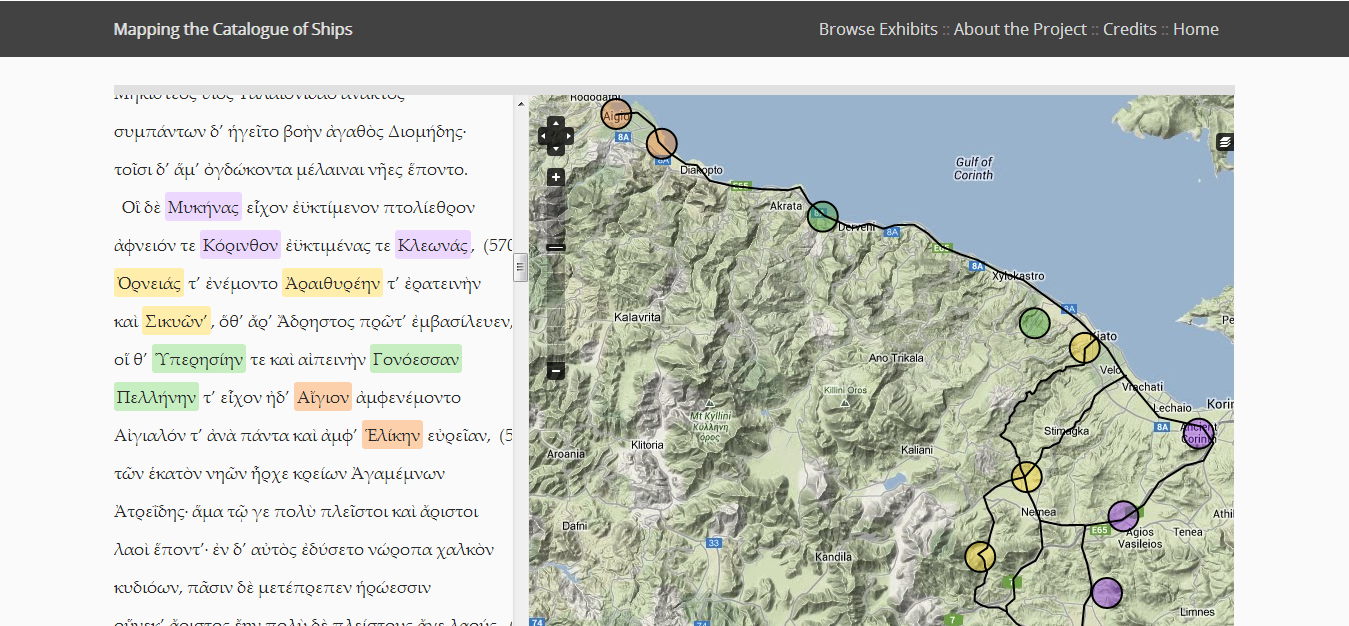Most readers of Homer’s “Iliad” recall the “Catalogue of Ships” as its own epic act of endurance, for reader and poet alike.
Nearly 190 place names and 29 Greek contingents, sailing to Troy for battle, are cited in more than 250 lines, requiring what U.Va. classics professor Jenny Strauss Clay considers a “tour-de-force” of memory from the oral poet.
Earlier this year, Clay and a pair of graduate students in the Department of Classics collaborated with the Scholars’ Lab to apply mapping technologies to the sprawling catalogue from Book Two of the “Iliad.” They wanted to test the theory that Homer was able to recite the detailed catalogue by creating a mental journey using mnemonic techniques linking actual locations from ancient Greek civilization.
Their innovative work with digital tools to analyze one of the most studied pieces of literature in the Western canon won graduate students Courtney Evans and Ben Jasnow the Alliance of Digital Humanities Organizations’ prestigious Paul Fortier prize, awarded for the best paper presented by junior scholars at the 2013 Digital Humanities Conference in July.
Their findings on the geographical itineraries potentially utilized by Homer in crafting the Catalogue of Ships could serve as a road map to undiscovered archaeological sites and launch new waves of research, Clay said.
“This is really just the beginning,” said Clay, the University’s William R. Kenan Jr. Professor of Classics. “The exciting thing about this project is we don’t know what’s going to happen next. Once the technical part of the project is made available, people can try different things. It’s meant as a tool for discovery, rather than sticking stuff in that you can pull out that you already know.”
Working with Geographic Information Systems specialists, programmers and designers in the University’s Scholars Lab, where students and researchers across disciplines partner on digital projects, Jasnow and Evans applied least-cost path analysis to Homer’s catalogue. It’s the same technique used by transportation departments to determine the least costly path for roadways, and the graduate students were able to plug in identified locations from the Catalogue to create an interactive map. To do that, they used Neatline, a tool created in the Scholars’ Lab with funding from the National Endowment for the Humanities and the Library of Congress. More importantly for Jasnow and Evans, the mapping technology allowed them to triangulate potential sites for other undiscovered locations cited in the Catalogue.
“He tends to organize around geographic areas,” Evans said of Homer, “So it’s often the case when he’s speaking about islands that he’ll use one verb to govern all the towns on that island, again showing an awareness of geography, or maybe he’ll even subdivide that island into geographical regions. This is another way of looking at space.”
Some of the distinct geographic patterns identified in the “Catalogue of Ships” text by the project appear to mirror potential, point-by-point travel itineraries, while others resemble more radial patterns, like clock faces rotating around central cities or locations.
Jasnow said they hope their findings can prove to be helpful not only to literary scholars, but also to archaeologists.
“There are times when Homer's syntax corresponds to features of the landscape, listing towns in a particular order, creating patterns we call syntactical groups,” he said. “But within that order there can be gaps, where the locations of towns are unknown. In these cases, the syntactical patterns may help connect the dots, allowing us to triangulate the location of a missing site, maybe helping archaeologists know where to look.”
Bethany Nowviskie, the University Library’s director of digital research and scholarship and special advisor to the provost, called the project one of the best examples of digital humanities scholarship that she’s worked on in her career.
“We’re applying unexpected digital methods to core humanities research questions,” she said. “and making new discoveries in one of the most ancient and thoroughly-studied texts in the world.”
While some people may not expect classicists to be working on the cutting edge of technologically assisted research, U.Va. faculty members have been at the vanguard of digital humanities, said John Miller, who chairs the Department of Classics.
“U.Va. faculty in classics have been active in virtual reality modeling of classical sites, ongoing formation of a digital library of all Latin from antiquity through the Renaissance, and digitally charting the complex movements of battling warriors in Homer’s ‘Iliad,’” Miller said. “Applying new tools of mapping technology has enabled Ben and Courtney, working with my colleague Jenny Clay, not only to offer fresh perspectives on old questions posed by a puzzling text, but also to uncover new knowledge about Homeric composition, the location of ancient sites and the broader culture of archaic Greece.”
At the U.Va. Library Scholars’ Lab, expert staff assist faculty and students with projects in the digital humanities and with geospatial information, physical computing, 3-D modeling, and desktop fabrication. The Scholars’ Lab hosts workshops and a popular lecture series, and supports emerging scholars through Graduate Fellowships in Digital Humanities and the Praxis Program.
Media Contact
Article Information
September 27, 2013
/content/innovative-research-homer-s-iliad-wins-prestigious-digital-humanities-prize

